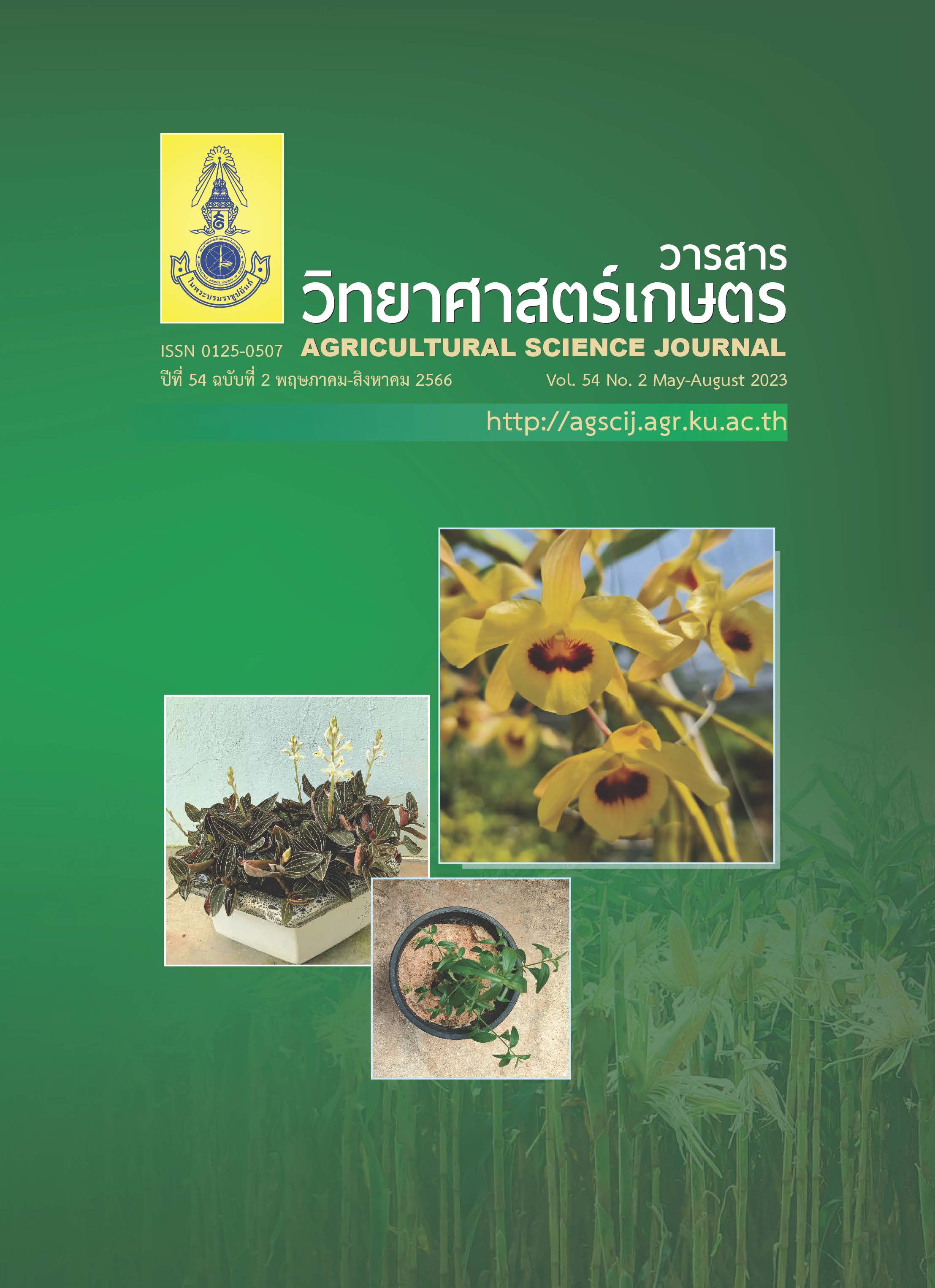Effects of Agricultural Substrates on Growth and Yield of Lentinus squarrosulus Mont.
Main Article Content
Abstract
Background and Objectives: White log mushrooms (Lentinus squarrosulus Mont.) are rich in nutrients, vitamins, and antioxidants but slowly grown. This experiment aimed to improve the cultured formulas for promoting growth and reducing the production cost of white log mushrooms.
Methodology: A completely randomized design with 5 replicates per treatment was used.
Main Results: The mother spawn experiment found that formula 7 (74% sorghum grains + 25% paddy grains + 1% glucose) and formula 6 (99% sorghum grains + 1% glucose) mixed with 1% glucose per bottle had more growth and mycelial density than the control formula 1 (100% sorghum grains). There were statistically significant differences (P < 0.05) between cultured formulas. The spawn run experiment of white log mushrooms in plastic bags presented that the higher proportion of rice husk increased growth rate, but mycelial density decreased. In addition, it was found that formula 2 (80% rubber sawdust + 10% rice husk + 5.5% rice bran + 2.5% ground leucaena + 1% lime + 0.8% gypsum + 0.2% epsom salt) and formula 3 (70% rubber sawdust + 20% rice husk + 5.5% rice bran + 2.5% ground leucaena + 1% lime + 0.8% gypsum + 0.2% epsom salt) had the mushroom yield of 146.31 and 139.40 g/bag and the biological efficiency (BE) of 42.05 and 41.94%, respectively which were not statistically different when compared to the control formula 1 (90% rubber sawdust + 5.5% rice bran + 2.5% ground leucaena + 1% lime + 0.8% gypsum + 0.2% epsom salt) with the yield of 150.14 g/bag and 43.51% BE.
Conclusions: This result showed that 20% of rice husks could be replaced with rubber sawdust to reduce the production costs of white log mushroom.
Article Details

This work is licensed under a Creative Commons Attribution-NonCommercial-NoDerivatives 4.0 International License.
References
Anike, F.N., O.S. Isikhuemhen, D. Blum and H. Neda. 2015. Nutrient requirements and fermentation conditions for mycelia and crude exo-polysaccharides production by Lentinus squarrosulus. Adv. Biosci. Biotechnol. 6(8): 526–536. http://doi.org/10.4236/abb.2015.68055.
Chanta, S. 2021. Growth and yield of Khon-Khao mushroom (Lentinus squarrosulus Mont.) cultured in different spawn materials. J. Sci. Tech. UBU. 23(3): 90–96.
Frimpong-Manso, J., M. Obodai, M. Dzomeku and M.M. Apertorgbor. 2011. Influence of rice husk on biological efficiency and nutrient content of Pleurotus ostreatus (Jacq. ex. Fr.) Kummer. Int. Food Res. J. 18: 249–254.
Jayachandran, A., S. Nadesan and K. Murugaiyan. 2017. Comparative study of different grains on spawn development of Pleurotus florida. IJSIT. 6(6): 728–735.
Katiyar, S., G. Singh, Mohit, S. Kumar and A. Soam. 2018. Effect of different sugars on spawn growth (mm) of milky mushroom (Calocybe indica). J. Pharmacogn. Phytochem. 7(5): 595–597.
Kent, N.L. 1983. Technology of Cereals: An Introduction for Students of Food Science and Agriculture. 3rd edition. Pergamon Press, Oxford, UK.
Mueller, J.C., J.R. Gawley and W.A. Hayes. 1985. Cultivation of the shaggy mane mushroom (Coprinus comatus) on cellulosic residues from pulp mills. Mushroom Newsletter for the Tropics. 6: 15–20.
Ngeapok, S., S. Banjongsiri and U. Unphim. 2018. Patterns and cost benefit of Khon-Khao mushroom of the farmer in Ubonratchathani province. J. Grad. Skon. 15(68): 101–112. (in Thai)
Nuangmek, W. and M. Titayavan. 2020. Cereal grain for spawn production of Astraeus sp. and the effects of host plants. Khon Kaen Agr. J. 48(Suppl. 1): 1173–1180. (in Thai)
Omar, N.A.M., N. Abdullah, U.R. Kuppusamy, M.A. Abdulla and V. Sabaratnam. 2011. Nutritional composition, antioxidant activities, and antiulcer potential of Lentinus squarrosulus (Mont.) mycelial extract. Evid. Based Complement. Alternat. Med. 2011: 539356. https://doi.org/10.1155/2011/539356.
Petcharat, V. 1995. Cultivation of wild mushroom: I. Lentinus squarrosulus Mont. Songklanakarin J. Sci. Technol. 17(1): 43–56. (in Thai)
Petcharat, V. 1998. Wild mushroom in Southern Thailand: II. Lentinus mushroom (Lentinus spp.). Songklanakarin J. Sci. Technol. 20(1): 35–40. (in Thai)
Srijumpa, N. and S. Khayankan. 2011. Agricultural wastes as substrate for mushroom cultivation. Thai Agric. Res J. 29(2): 108–118. (in Thai)
Srisuthum, J., A. Jindaprasert, C. Pukahuta and W. Krusong. 2014. Growth of Lentinus squarrosulus Mont LS-MA in submerged cultivation for xylinase production from dried baby corn husk, pp. 106–114. In Proc. the 52nd Kasetsart University Annual Conference, 4–7 February 2014. (in Thai)
Tantratian, S., P. Vattanakul, A. Pornvichitpisan, V. Kongpensook and C. Pukahuta. 2019. Effect of nutrients and temperature on growth of Lentinus squarrosulus Mont. LS-BUB-9. JFTSU. 14(2): 133–143. (in Thai)
Thomas, G.V., S.R. Prabhu, M.Z. Reeny and B.M. Bopaiah. 1998. Evaluation of lignocellulosic biomass from coconut palm as substrate for cultivation of Pleurotus sajor-caju (Fr.) Singer. World J. Microbiol. Biotechnol. 14: 879–882. https://doi.org/10.1023/A:1008881124903.
Umpuch, K., J. Iamchom and P. Yim-orn. 2017. Using ground leucaena branches for oyster mushroom-Hungary cultivation in summer, pp. 53–57. In Proc. the 8th RMUTP International Conference on Science, Technology and Innovation for Sustainable Development: Challenges Towards the Digital Society, 22–23 June 2017. (in Thai)
Zadrazil, F. and H. Brunnert. 1980. The influence of ammonium nitrate supplementation on degradation and in vitro digestibility of straw colonized by higher fungi. European J. Appl. Microbiol. Biotechnol. 9: 37–44. https://doi.org/10.1007/BF00500000.

